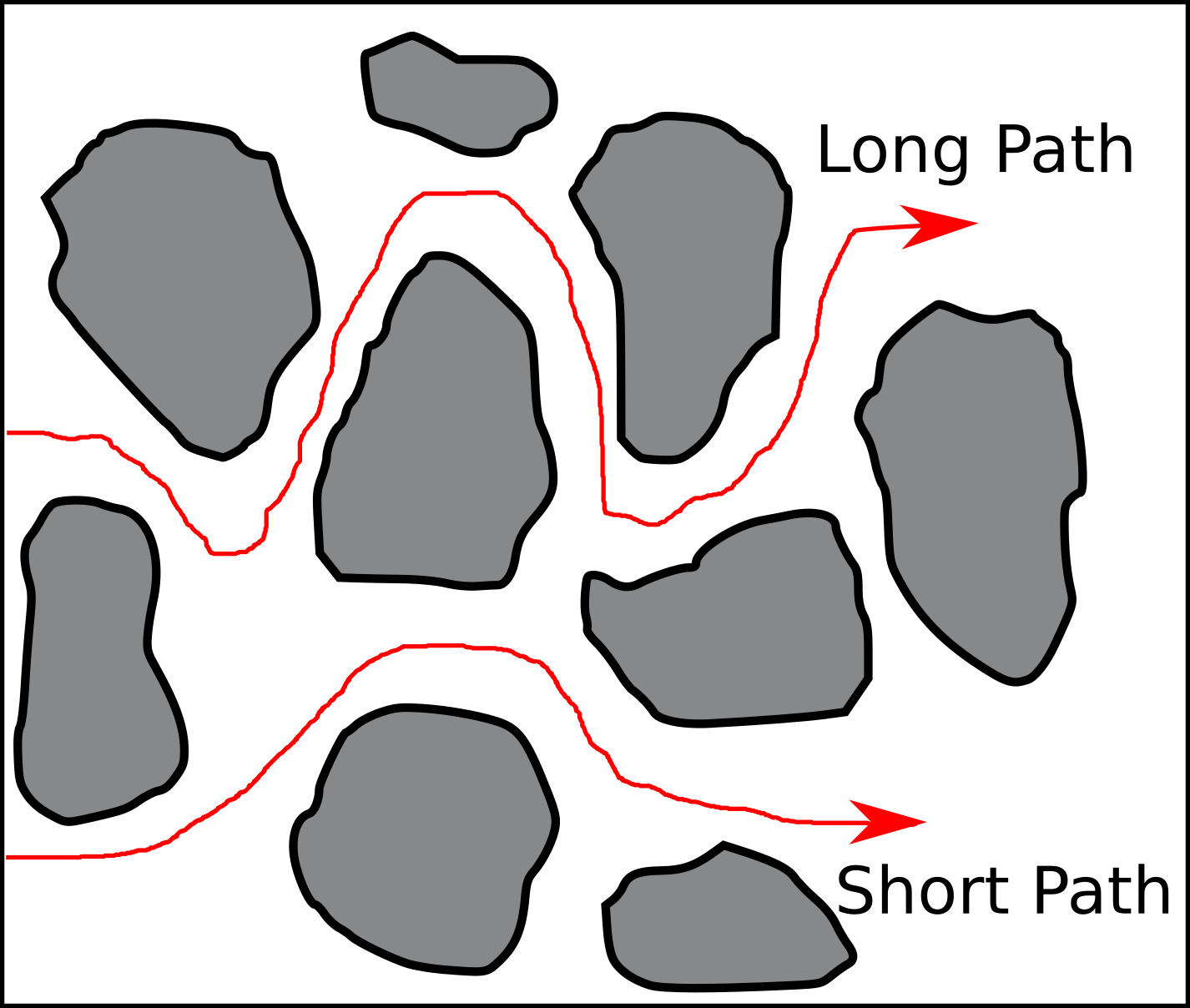Disclaimer: The following discussion applies fully to ions that only interact with bentonite by means of being part of an electric double layer. Species with more specific chemical interactions will be discussed in separate blog posts.
The traditional diffusion-sorption model
A persistent idea, that has been around since the very start of research on compacted bentonite1, is that “sorbed” ions are immobilized, and early diffusion models were based on two assumptions
- The entire pore volume contains bulk water, where ions diffuse according to \begin{equation} j = -D_e \nabla c \tag{1} \end{equation} where \(c\) is the ion concentration and \(D_e = \phi D_p\), with \(\phi\) being the porosity, and \(D_p\) a so-called pore diffusivity (containing information on the ion mobility at the macroscopic scale of the porous system).
- Ions in the porewater “sorb” on solid surfaces and become immobilized. The amount of “sorbed” ions per unit solid mass, \(s\), is related to \(c\) via a distribution coefficient \(K_d\) \begin{equation} s = K_d\cdot c \tag{2} \end{equation}
With these assumptions, the total amount of ions in the bentonite (per volume porous medium) is
\begin{equation} n = \phi\cdot c + \rho\cdot s = \left (\phi+\rho K_d \right) c \tag{3} \end{equation}
where \(\rho\) is the (dry) density of the clay. Applying the continuity equation, \(\partial n/\partial t = -\nabla\cdot j\), gives
\begin{equation} \frac{\partial c}{\partial t} = \frac{D_e}{\phi + \rho K_d}\nabla^2c \tag{4} \end{equation}
This equation is usually written in terms of the so-called apparent diffusion coefficient \(D_a\)
\begin{equation} \frac{\partial c}{\partial t} = D_a \nabla^2c \tag{5} \end{equation}
with
\begin{equation} D_a = \frac{D_e}{\phi + \rho K_d} \tag{6} \end{equation}
The model defined by eqs. 5 and 6 — which we will refer to as the traditional model — has a distinct physical interpretation: ions diffuse relatively fast in a bulk water phase, while being retarded due to “sorption” onto the solid surfaces. Although eq. 5 has the form of Fick’s second law, it is clear that \(D_a\) is not a real diffusion coefficient, but is influenced both by diffusion (\(D_e\)) and “sorption” (\(K_d\)).
The immobilization assumption is not valid
The traditional model has a major problem: it is not valid for compacted bentonite. There is — and was — strong evidence that the immobilization assumption does not hold for all types of “sorbing” ions. E.g Jenny and Overstreet (1939) reported transport of \(\mathrm{Fe^{2+}}\), \(\mathrm{H^+}\), \(\mathrm{K^+}\), \(\mathrm{Na^+}\), and \(\mathrm{Ca^{2+}}\) as samples of H- K- Na- and Ca-bentonite was brought in contact with samples of Fe/H-bentonite (without gel contact there was no transport), and van
Schaik et al. (1966) demonstrated steady-state fluxes of \(\mathrm{Na^+}\) through Na-montmorillonite, corresponding to pore diffusivites significantly larger than the \(\mathrm{Na^+}\) diffusivity in pure water. Moreover, ion mobility is an essential component of the most well-established theoretical concept used for describing montmorillonite — the electric double layer. The ionic part of the electric double layer is even referred to as the diffuse layer, for crying out loud!2
So it should come as no surprise that the pioneers in radwaste barrier research quickly came to the conclusion that the description underlying eq. 6 does not hold. Several research groups reported values of \(K_d\) and \(D_a\) that gives unreasonably large values of \(D_e\) when evaluated using eq. 6 (even larger than the corresponding diffusivities in pure water, in several cases).
What is more surprising is that these conclusions did not lead to a complete reevaluation of the underlying assumptions, which is the preferred procedure for a model producing nonsense. Instead, the invalidity of the traditional model was only considered a problem for the specific ions for which it yield “unrealistic” parameter values (in particular, strontium and cesium), and an adopted “remedy” was the so-called surface diffusion model. The surface diffusion model keeps the description expressed by eqs. 1, 2, 5, and 6, while replacing the relation \(D_e = \phi\cdot D_p\) with the following monster
\begin{equation} D_e = \phi\cdot D_p + \rho\cdot K_d\cdot D_s \tag{7} \end{equation}
where \(D_s\) is a so-called surface diffusion coefficient.
This extension of the traditional model brings about several problems, the most glaring one being that eq. 7 is wrong. Therefore, to be able to continue the discussion, we first have to derive a correct “surface diffusion”3 model.
A correct “surface diffusion” model
Eq. 7 is not valid because it relies on the incorrect assumption that diffusive fluxes from different domains are additive. To derive the correct equations, we go back to the only conceptual modification made in the surface diffusion model: that the “sorbed” ions are no longer assumed immobile. Thus, the basic assumptions of the surface diffusion model are:
- The entire pore volume contains bulk water, where ions diffuse.
- Ions in the porewater “sorb” on the solid surfaces.
- “Sorbed” ions also diffuse, along the surfaces.
There are consequently two domains (bulk water and surfaces) where diffusion is assumed to take place, and a correct equation for the macroscopic flux is in this case (for details, see here)
\begin{equation} j = -\phi D_\mathrm{macr.} \frac{\bar{c}}{c}\nabla c \tag{8} \end{equation}
where \(D_\mathrm{macr.}\) is the diffusion coefficient on the macroscopic scale, which conveys information on the mobility in both of the involved domains, as well as their geometrical configuration. \(\bar{c}\) is the average concentration of all mobile entities; here, this include all ions — those in the porewater as well as those on the surfaces. The bulk water concentration is still labelled \(c\). Using eq. 3, we can write
\begin{equation} \phi\bar{c} = n = \left (\phi + \rho K_d \right) c \tag{9} \end{equation}
and eq. 8 reduces to
\begin{equation} j = – D_\mathrm{macr.}\left (\phi + \rho K_d \right) \nabla c \tag{10} \end{equation}
Comparing with eq. 1 directly shows
\begin{equation} D_e = D_\mathrm{macr.}\left (\phi + \rho K_d \right) \tag{11} \end{equation}
Further, when using eq. 10 in the continuity equation, the factor \(\left (\phi + \rho K_d \right)\) cancels, giving
\begin{equation} \frac{\partial c}{\partial t} = D_\mathrm{macr.} \nabla^2 c \tag{12} \end{equation}
A complete conceptual change
Eqs. 11 and 12 are the main result of a correctly derived “surface diffusion” model. Comparing with eqs. 5 and 6, we see that, although the equations are deceptively similar, a “surface diffusion” model brings about a complete conceptual change: with the immobilization assumption released, it is actually the real diffusion coefficient that appear in Fick’s second law (eq. 12). In fact, the surface diffusion model does not contain any apparent diffusivity!
Similarly, \(D_e\) is not a real diffusion coefficient in the surface diffusion model, as clearly seen by eq. 11. Rather, \(D_e\) is the product of the diffusion coefficient and a concentration factor, stemming from the fact that the general flux equation reads \(j = -\frac{D}{RT} \bar{c}\cdot \nabla \mu\), where \(\mu\) is the chemical potential of the diffusing ion.
In the same vein, \(K_d\) does not quantify “sorption” — at least if “sorption” is supposed to refer to a process that retards the diffusive flux. On the contrary, \(K_d\) acts as a kind of amplifier of the flux (eq. 10). This implication was already pointed out by Jahnke and Radke (1985):
Thus, \(K_d\) values are of extreme importance during the steady release period. Counter to what may have been anticipated, larger \(K_d\) values lead to higher release rates.
The conceptual changes of a “surface diffusion” model make a lot of sense when interpreting diffusion data:
- \(D_e\) is expected to vary with \(K_d\) and can basically grow without limit, without becoming unphysical.
- “\(D_a\)” for a whole bunch of cations is universally found to be insensitive to changes in \(K_d\), even though \(K_d\) may vary orders of magnitudes (by altering the background concentration). This is the expected behavior of a real diffusion coefficient, and it makes all sense to instead interpret this parameter as \(D_\mathrm{macr.}\), using eq. 12.
- When assuming all ions in the system to be mobile, we expect the governing equation (eq. 12) to be a real Fick’s second law, i.e. that it contains nothing but the actual diffusion coefficient.
Despite this sense-making, I have never seen these points being spelled out in the bentonite literature. Rather, it appears as the implication of releasing the immobilization assumption has not been fully comprehended. To this day, the traditional model is used as the basis for interpretation in basically all publications, to the extent that “\(D_a\)”, “\(D_e\)”, and “\(K_d\)” usually are considered to be experimental quantities. Similarly, most modern model development is focused on extending the traditional model, using flawed concepts regarding diffusivity in multi-porous systems.
I also find it symptomatic that “surface diffusion” not uncommonly is treated as being an optional mechanism, or even being completely discarded, while the dominant contribution of “sorbed” ions to the diffusive flux seems to have to be rediscovered every 25th year, or so.
Note that the conclusions made here are not based on any model that I favor, but are the consequence of a correct conceptual treatment of what is stated in the contemporary bentonite literature. Although a “surface diffusion” model (correctly treated!) make much more sense as compared with the traditional model in interpreting cation tracer diffusion, it still involves an assumption that I don’t understand how anybody can endorse: it assumes the entire pore volume to consist of bulk water. I will discuss this point in a separate blog post. Update (210225): Letting go of the bulk water is discussed here.
Footnotes
[1] In the following I will write “bentonite”, but I mean any type of clay system with significant ion exchange properties.
[2] I guess a reason for not acknowledging interlayer diffusivity could have been the incorrect notions that interlayer water is crystalline, and that diffuse layers only “form” at higher water content.
[3] Since the established surface diffusion model is that expressed by eq. 7, I use quotation marks when speaking about models that don’t comply with this equation.














